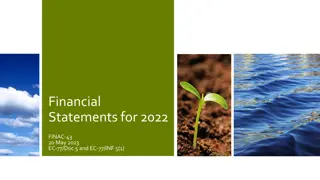
Governing Firm-Community Relationships: Contracts and Risks
Understanding how firms use contracts to govern relationships with non-market stakeholders like local communities, activists, and NGOs. Explores the role of Transaction Cost Economics (TCE) in mitigating holdup risks through mechanisms like Community Benefits Agreements (CBAs) in firm-community transactions. Analyzes factors influencing the choice to use contracts and the challenges involved in implementing CBAs.
Download Presentation

Please find below an Image/Link to download the presentation.
The content on the website is provided AS IS for your information and personal use only. It may not be sold, licensed, or shared on other websites without obtaining consent from the author. If you encounter any issues during the download, it is possible that the publisher has removed the file from their server.
You are allowed to download the files provided on this website for personal or commercial use, subject to the condition that they are used lawfully. All files are the property of their respective owners.
The content on the website is provided AS IS for your information and personal use only. It may not be sold, licensed, or shared on other websites without obtaining consent from the author.
E N D
Presentation Transcript
Contracting Beyond the Market Odziemkowska and Dorobantu (2021)
Recent phenomena: increasing levels of tension and collaboration between firms and some of their non-market stakeholders (e.g., local communities, activists, nongovernmental organizations) Uses TCE to understand when and why firms use contracts to govern their relationships with non-market stakeholders. Theory of governance of transaction of access to resources TCE s Discriminating alignment hypothesis : governance structures (e.g., contracts, alliances hierarchical organization), which differ in their costs and competences, are aligned with transactions, that differ in their attributes, in an economizing way to reduce contractual hazards that arise from the nature of the transaction (Williamson 1985), of the underpinning technology exchanged (Oxley 1997), or of the political environment in which the transaction takes place (Henisz and Williamson 1999). Introduction RQ: What factors can explain the use of contracts to govern some relationships between firms and non-market stakeholders but not others? Short answer: property rights, negative externalities from use of resources, and community s collective mobilization in focal relationships generate various potential for conflict and holdup characterizing their relationships.
Firm-Community Transactions and Holdup Risk for the Firm - An access transaction doesn t require ownership by the party granting access and doesn t transfer resource ownership of the to the firm. Local communities provide firms access to a critical resource a location by granting or withholding their consent to the firm s entry and continuing operations. Granted firms can get inputs and markets for outputs, while granting communities can reap benefits of employment, opportunities for local businesses, and minimize negative externalities such as pollution or disruption. Ex-post holdup risk: After making site-specific investments, the firm loses bargaining power, leading to great losses. - Transaction Cost Economics and Firm-Community Contracts - - Governance mechanisms that ensure continued access to a site - - Spot-market transactions: insufficient to secure long-term access Informal (relational) governance: not immune to unforeseen disturbances such as negative externalities CBA (community benefits agreements): ensures long-term access even after site-specific investments. But they are costly (ex-ante transaction costs), so firms are selective. -
CBAs as an adjustable framework Specifying the terms of the exchange: The benefits provided to the local community and the commitment that firm will mitigate the negative impacts of its activities on the local community The means to resolve possible disagreements: through arbitration rather the court to resolve conflict Complementary relational governance resulting from frequent and repeated interactions between community members and firm representatives More likely to align two parties interests over the long term Transaction Cost Economics and Firm-Community Contracts Costs for using CBAs as the governance mode: costly to negotiate and implement; takes a long time and requires dedicated resources (e.g., experienced negotiators and managerial time), Need to share the value created with the local community Selectively use for certain access transactions community and firm interests are most likely to diverge the community has legal or regulatory recourse to challenge the firm the community s capacity to hold up the firm through sanctions (e.g., protests, blockades, petitions)
Property rights as bundles of rights (a)The right to use the asset (usus); focus of this paper (b)The right to appropriate returns from the asset (usus fructus); (c)The right to change its form, substance, and location (abusus) Community Property Rights and the Risk of Holdup When the local community possesses the use right (usus): The higher potential for conflicts: When multiple parties have use rights over the same asset (Alchian 1965), one party s use may impinge the benefits derived by another s use of the same asset. This is due to interest misalignment. The greater legal standing and bargaining power: Local community can claim that their use rights are impinged by others use of the asset and use their position to seek recourse through the judicial system or through regulatory sanctions. H1:The probability that a firm signs a contract with a community is higher when the community possesses use rights over the asset or site sought by the firm.
Coase (1960): If transaction costs were zero or negligible, a firm and an affected stakeholder should negotiate a mutually beneficial agreement in which either the firm would compensate the stakeholder for the harm inflicted or the stakeholder would incentivize the firm to discontinue its activity to avoid inflicting harm. For mine industry High misalignment/conflict costs: Firm s site-specific investment: Ex-post hold up problem Property rights develop to internalize externalities when the gains of internalization become larger than the cost of internalization Externalities and the Risk of Holdup Contract for externalities ex ante by negotiating and signing a CBA formalizing commitments to mitigate externalities providing monitoring mechanisms Providing a framework for conflict resolution H2:The probability that a firm signs a contract with a community is higher when the community bears a risk of negative externalities
Community mobilization: communities block firms physical access, organize partitions, or or seek local ordinances to block access, rather than relying on formal sanctions. TCE assumption: exchange partners behave as unitary actors that can articulate their interests and act to protect those interests. This may not hold for nonmarket actors representing collectives. Local communities differ in their capacity to organize collectively. The collective action problem the challenges of collective decision making and free riding. requires the capacity to articulate and explicate collective interests. a) relies on coordination devices, such as social networks requires time and frequent iterations (compared with hierarchy) b) require specific capabilities for the process of defining the collective interest and the action of explicating it to an external party Community Mobilization Experience and the Risk of Holdup Proxy: Local communities previous mobilization experience through collective action experiences, a shared understanding of their communities goals and interests, relationships, and norms for monitoring and coordinating mechanisms for subsequent action H3:The probability that a firm signs a contract with a community is higher when the community has capacity for collective mobilization.
Collective mobilization can be particularly effective if accompanied by credible claims of use rights infringement or negative externalities, because such claims are more likely to garner greater numbers of sympathizers, may mobilize others to join in the action, and are less likely to be dismissed by authorities. The Interaction Effect for the Risk of Holdup H4: The probability that a firm signs a contract with a community is higher when the community has capacity for collective mobilization and has use rights and/or a risk of negative externalities.
Sample: 5,739 observations representing the dyadic relationships between 124 mines and the indigenous communities within 500 km of these mines Dependent Variable: CBA: a dyad-level dummy, coded one if a mine-community dyad has signed a CBA and zero otherwise. Independent Variables: Use Rights: coded one for communities with use rights over the land where the mine is located and zero otherwise. Social externalities: coded one when the community is within a 50-km drive on the NRN from the mine s point on the NRN and zero otherwise. Institutional mobilization: a count of the number of times that a community mobilized through institutional channels the judicial system or the regulatory process in the preceding 10 years. Extra-institutional mobilization: a count of the number of times that a community mobilized via extra-institutional tactics, such as protests or blockades. Control Variables: whether the community has full property rights; Dyad-level: mine-community geodesic distance, past conflict in dyad, extra-institutional mobilization by distant communities; Community-level: community s past CBAs, proximate community CBAs, community s population, employment rate of the community, percentage indigenous language speakers Data and Methods
Results grouping dyads into four combinations of the hypothesized covariates. All hypotheses are corroborated.


















